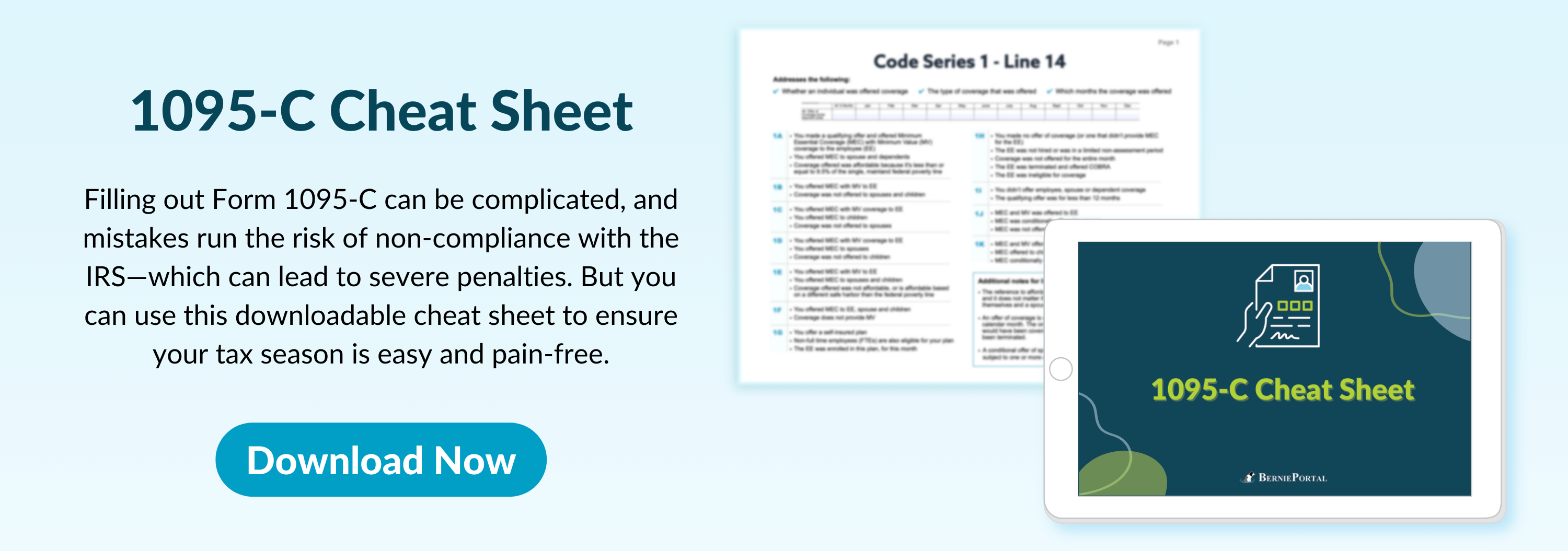
Written by
Aidan Farrish
Aidan is an aPHR-certified writer on the marketing team at BerniePortal. She writes about HR, healthcare, and benefits.
Alphabet Soup: Definitions for All the Acronyms Brokers Use

If you're a health insurance advisor, you're probably well-acquainted with the endless string of acronyms that make up your daily lexicon. For newcomers, this "alphabet soup" can be daunting (writing it sure was), and even seasoned pros might need a refresher from time to time. Or, something you can link for people as a resource, like employer clients. In this blog, we'll break down some of the most common acronyms you encounter, sorted by category for easy reference.
See something we missed? Let us know in the comments, and we will add it!
Acronyms for Laws, Regulations, and Government Entities
ACA - Affordable Care Act
The ACA, sometimes known as "Obamacare," is a comprehensive healthcare reform law enacted in March 2010. Its main goals are to make affordable health insurance available to more people, expand the Medicaid program, and support innovative medical care delivery methods.
Employers must accurately fill and file 1095-Cs and 1094-Cs each year to comply with the ACA, and many employers lean on their benefits broker for help. To more strategically serve your clients, use BerniePortal’s 1095-C Cheat Sheet, or provide it to employers overwhelmed by ACA compliance.
ADA - Americans with Disabilities Act
The ADA is a civil rights law that prohibits discrimination against individuals with disabilities in all areas of public life, including jobs, schools, transportation, and all public and private places that are open to the general public.
COBRA - Consolidated Omnibus Budget Reconciliation Act
COBRA provides eligible employees and their dependents the option to continue health insurance coverage after losing their jobs or experiencing another qualifying event. This can be a crucial safety net during times of transition. A TPA such as Alpine can administer COBRA and increase compliance tenfold for employers, especially as it works alongside the offboarding feature of BerniePortal.
DOL - Department of Labor
The DOL is a federal agency that oversees workplace safety, wage standards, unemployment insurance benefits, re-employment services, and some economic statistics. It plays a key role in enforcing the FLSA and other labor laws.
EEOC - Equal Employment Opportunity Commission
The EEOC is an organization responsible for enforcing federal laws that make it illegal to discriminate against a job applicant based on various factors. These include a person’s race, color, religion, sex, national origin, age (40 or older), disability, or genetic information. The EEOC covers most employers with at least 15 employees.
It also investigates charges of discrimination and focuses on settling them when discrimination is found. If charges can’t come to an agreement, the EEOC may file lawsuits on behalf of the individual or the general public.
ERISA - Employee Retirement Income Security Act of 1974
ERISA is a federal law that establishes the minimum standards for most retirement and healthcare plans in the private sector. Enforced by the DOL, the law is designed to protect employees who enroll in these employer-sponsored benefits. Unlike Affordable Care Act (ACA) requirements, ERISA applies to employers of all sizes who offer qualified plans, and noncompliance can be costly.
ERISA covers any retirement plan that provides either retirement income in the future or the opportunity for employees to contribute current wages to retirement. Major plans covered under ERISA also include:
- Major medical plans
- Dental
- Vision
- Prescription benefits
- FSAs
- HSAs
- Specific EAPs
- Wellness programs
- Cancer policies
Plans that do not fall under ERISA primarily include pensions or other plans provided by the United States government, state or local governments, and churches.
FLSA - Fair Labor Standards Act
The FLSA establishes minimum wage, overtime pay, recordkeeping, and youth employment standards affecting employees in the private sector and in federal, state, and local governments. It's a cornerstone of labor law in the United States. Your employer clients, especially small businesses, think about the FLSA daily. Their payroll compliance is a top concern, so it should be one of yours, too. This is why many employers prefer an all-in-one HRIS like BerniePortal, which provides payroll with native timekeeping, PTO tracking, and a robust benefits administration system.
FMLA - Family and Medical Leave Act
FMLA provides certain employees with up to 12 weeks of unpaid, job-protected leave per year and that their group health benefits be maintained during the leave. This law applies to all public agencies, public and private elementary and secondary schools, and companies with 50 or more employees.
FTC - Federal Trade Commission
The FTC is a federal agency that enforces consumer protection and antitrust laws to protect consumers and ensure a strong competitive market. In the context of health insurance, the FTC can be involved in cases of fraud and other deceptive practices.
HIPAA - Health Insurance Portability and Accountability Act of 1996
HIPAA is a federal law that requires all organizations to protect what’s considered PHI from being disclosed to unauthorized persons. Unless state law is more stringent than federal law, HIPAA overrides state law regarding data privacy.
IRS - Internal Revenue Service
The IRS is the U.S. government agency responsible for tax collection and tax law enforcement. In the context of health insurance, the IRS is heavily involved in the administration of tax-related provisions of the ACA.
Acronyms for Brokerage Agencies
BOR - Broker of Record
The BOR is a designation given to an insurance agent or broker who represents the insured party. This designation grants the broker the authority to manage the policy, negotiate renewals, and earn commissions. Changing the BOR is as simple as signing a single sheet of paper that is then sent to insurance carriers.
EOB - Explanation of Benefits
An EOB is a statement sent by a health insurance company to covered individuals explaining what medical treatments and/or services were paid for on their behalf. It's not a bill but rather a breakdown of costs and coverage.
EOI - Evidence of Insurability
An EOI is an application process where you provide information on the current and past condition of your health, your spouse’s health, and your dependent’s health in order to enroll in certain types of insurance coverage.
COB - Coordination of Benefits
COB refers to the process used by health insurers to avoid duplicate payments by coordinating the benefits when a policyholder is covered by more than one plan. This ensures that the combined payments from all insurance plans do not exceed the total charges.
PBM - Pharmacy Benefit Manager
PBMs are third-party administrators of prescription drug programs for health insurance plans. They negotiate with drug manufacturers and pharmacies to control drug spending and manage the prescription drug benefit for insurers.
PHI - Protected Health Information
PHI is generally any information in medical records that can be used to identify an individual. For more information, read BerniePortal’s HIPAA blog, which has a section dedicated to broker compliance with PHI.
Acronyms for Insurance Terms
EAP - Employee Assistance Program
An EAP is an employee benefit that assists workers with personal or work-related problems that may impact their job performance and physical or mental health. EAPs generally offer free and confidential mental health assessments, short-term counseling, referrals, and follow-up services for employees. In essence, EAPs are critical work-based support tools that help employers show they care about the well-being of their workforce.
HDHP - High Deductible Health Plan
An HDHP is a type of healthcare coverage that requires participants to spend more on up-front costs before the insurance company begins to contribute to covering expenses. In many cases, people with HDHPs spend less per month on premiums.
Different types of healthcare coverages can be considered HDHPs. Additionally, HDHPs can be paired with HSAs to help users pay for qualified medical expenses using tax-advantaged dollars.
LDHP - Low Deductible Health Plan
LDHPs may cost more upfront in the form of higher premiums, but they require less medical cost before the deductible is met than HDHPs. These plans are designed for an individual or a family who foresees regular medical care.
HMO - Health Maintenance Organization
An HMO is a type of health insurance plan that provides people with all in-network care. Therefore, employees or individuals covered by an HMO have one primary care physician for appointments and are not permitted to receive covered care out-of-network.
HSA - Health Savings Account
An HSA is a tax-advantaged medical savings account available to taxpayers enrolled in a high-deductible health plan (HDHP). Funds contributed to an HSA are not subject to federal income tax at the time of deposit. Limits increase annually, so remain up to date.
HRA - Health Reimbursement Arrangement
An HRA is an employer-funded plan that reimburses employees for out-of-pocket medical expenses and, in some cases, insurance premiums. It's a great way for employers to provide tax-advantaged health benefits.
ICHRA - Individual Coverage HRA
Established by a federal ruling in 2019, ICHRAs are account-based health plans that allow employers to better control healthcare costs by providing employees with defined, non-taxed reimbursements for qualified health insurance expenses. This can include monthly premiums for individual plans purchased through the Marketplace or through private insurance companies.
FSA - Flexible Spending Account
An FSA is a special account you put money into that you use to pay for certain out-of-pocket health care costs. You don’t pay taxes on this money, making it a tax-advantaged benefit.
DFSA - Dependent Care Flexible Spending Account
A DFSA is a pre-tax benefit account used to pay for dependent care services such as preschool, summer day camp, before or after-school programs, and child or elder daycare.
MEC - Minimum Essential Coverage
One key provision in the ACA states that all ALEs must offer a health insurance plan that qualifies as MEC (don’t you love acronyms?). Employers are subject to penalties if their healthcare plans do not meet MEC requirements, so it’s critical for you to keep track of your clients’ spending.
PPO - Preferred Provider Organization
A PPO allows for the maximum amount of freedom and an extensive plan network. With this option, you are responsible for managing your health and need no referral to see a specialist.
PTC - Premium Tax Credit
The PTC is a refundable tax credit designed to help eligible individuals and families with low or moderate income afford health insurance purchased through the Health Insurance Marketplace.
QSEHRA - Qualified Small Employer Health Reimbursement Arrangement
A QSEHRA allows small employers to contribute to their employees’ healthcare expenses by providing non-taxed reimbursements to employees who maintain MEC.
STD - Short-Term Disability
STD is a benefit some employers offer to allow employees to take a specific amount of time off, usually 3-6 months. This aids employees who may have suffered an illness or injury with a lengthy recovery time.
LTD - Long-Term Disability
LTD is a benefit some employers offer to allow employees to take long sabbaticals from work, usually beginning at 6+ months but lasting as long as an employer may determine. There’s also a waiting period—called the elimination period—before a covered employee will start receiving payments from their long-term disability plan. Depending on the policy, the amount of time is usually 90 days, whereas STD payments will kick in much sooner.
Read BerniePortal's HR blog, What is the Difference Between Short-Term and Long-Term Disability?, to learn more about how employers consider STD and LTD.
Acronyms for Business and Technology Terms
ALE - Applicable Large Employer
According to the ACA), an ALE is an organization that employs at least 50 full-time employees, including FTE) employees, on average during the prior calendar year. Seasonal workers do not count toward this total. ALEs are subject to the employer shared responsibility provisions and special reporting provisions like Form 1095-C.
EIN - Employer Identification Number
An EIN is a number that the IRS assigns to businesses to identify the tax accounts of employers and others who have employees. The IRS can use EINs to identify taxpayers who have to file various business tax returns.
FTE - Full-Time Equivalent/Equivalency
FTE represents an employee’s total hours worked divided by the number of compensable hours in a full-time schedule during a fiscal year. For example, if an employer’s workweek is set at 50 hours—or five 10-hour days—and an employee works all 50 hours each week, their FTE would be 1.0.
HRIS - Human Resources Information System
An HRIS is a software solution that provides HR administrative services to employers. An HRIS can be a stand-alone solution that only provides one service, like performance management, or an all-in-one solution, which manages the administrative tasks of the full employee lifecycle, such as BerniePortal.
SaaS - Software as a Service
SaaS is a method of software delivery in which applications are hosted by a service provider and made available to customers over the Internet. In the insurance industry, SaaS platforms are used for everything from client management to policy administration. An HRIS counts as a SaaS and can provide benefits administration services that connect the employee, employer, broker, and insurance carrier all on one platform to administer the best health plans at the most effective cost.
SMB - Small to Midsized Business
SMBs range between 1 - 500 employees and make, on average, less than a few hundred million dollars in annual revenue.
TPA - Third-Party Administrator
A TPA is an organization that manages services for a different company. In an insurance context, TPAs often handle tasks such as processing claims, managing enrollments, and providing customer service, often serving as an intermediary between the insurer and the insured.
Understanding these acronyms is crucial for navigating the complex world of health insurance. Whether you're new to the field or a seasoned pro, keeping this cheat sheet handy can help demystify the jargon and make your job a little easier.
Feel free to share this guide with your colleagues, and look for more tips and tricks in our upcoming blogs! If you notice we’re missing something, comment, and we will add it.
Additional Resources:
- Brokers’ Corner Podcast—watch and subscribe to the Brokers’ Corner podcast, which dives into the topics that affect your agency and industry and identifies strategies so you can protect and grow your book of business
- BerniePortal Brokers’ Council—a council of benefits brokers from across the country that advises BerniePortal on industry concerns, trends, and the ways technology can best support their agency and employer groups
- BerniePortal for Brokers—leveraging technology to increase your agency valuation and support your employer groups is easier than ever with BerniePortal’s software solution, built for brokers by brokers

Written by
Aidan Farrish
Aidan is an aPHR-certified writer on the marketing team at BerniePortal. She writes about HR, healthcare, and benefits.
Related Posts
The IRS announced in May 2025 the updated HSA contribution limits for 2026, which take...





Submit a Comment